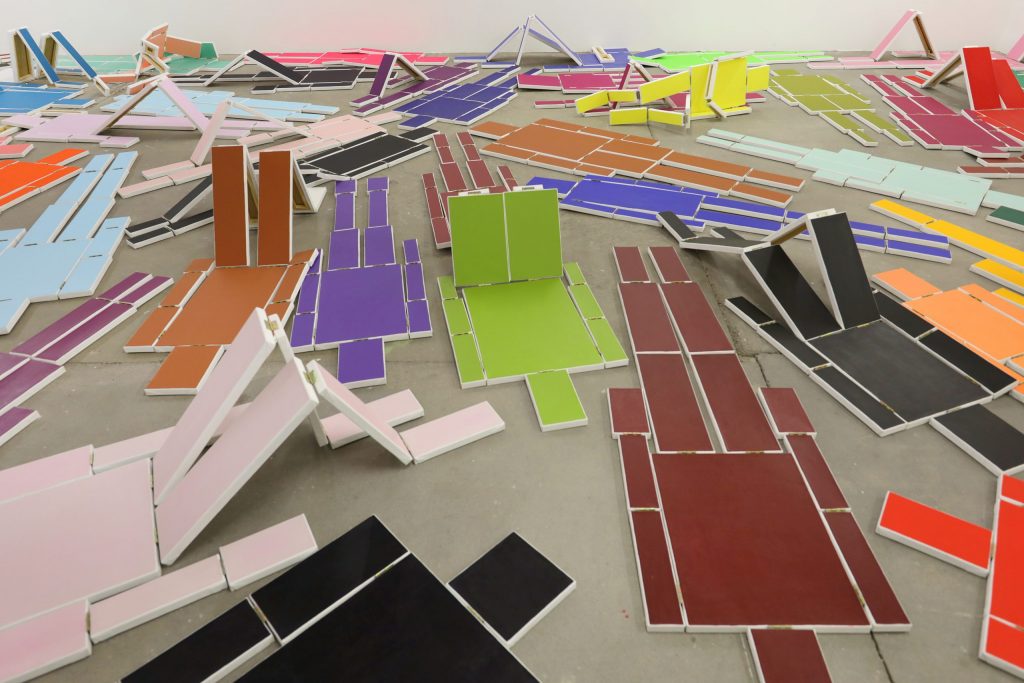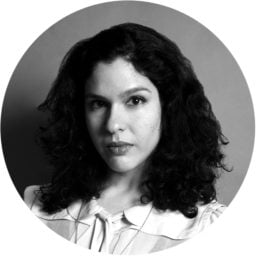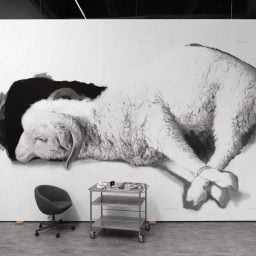What does it mean to hold a biennial exhibition in a year like this one?
Beyond the practical limitations, compounded by the fact that many participating artists can’t travel to their own shows, any major art event taking place in 2020 necessarily makes a statement about the world we live in. In the case of the 11th Berlin Biennale, the curatorial vision that guided it came to form over the last two years, largely before the pandemic changed everything. So it is especially poignant that the show’s central issues—postcolonial struggle, gender-based and race-based injustice, queer-phobia, and the unequal impacts wrought by climate change—have met a world where these very same problems have reached an unbearable climax.
Postponed from June to September, the show, called “The Crack Begins Within,” welcomed socially-distanced visitors across its four locations last weekend as one of the few international art events to physically open in Europe this year, despite rising infection rates. Curators María Berríos, Renata Cervetto, Lisette Lagnado, and Agustín Pérez Rubio—who are all based in South America—invited artists largely hailing from the Global South. The majority are women, many identify as queer, and few have yet to be widely exhibited in Europe.
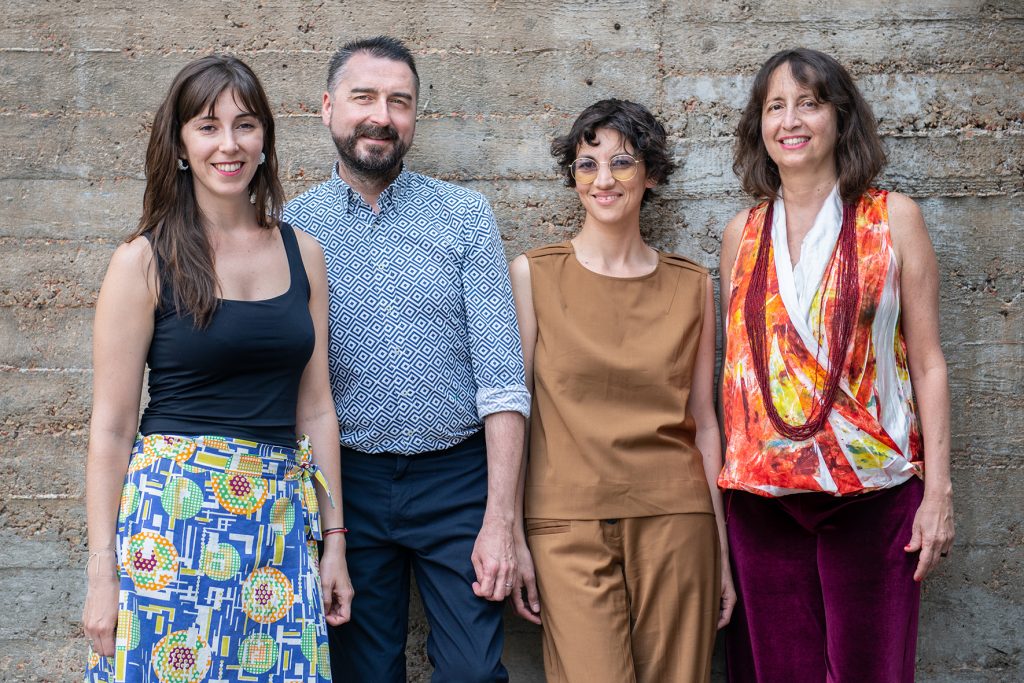
Curators of the 11th Berlin Biennale for Contemporary Art, f. l. t. r.: Renata Cervetto, Agustín Pérez Rubio, María Berríos, Lisette Lagnado. Photo: F. Anthea Schaap
“It makes us extremely sad that we cannot welcome most of the participants personally at this year’s biennale because they live in high-risk areas,” Berlin Biennale’s director Gabriela Horn said in a video statement sent to the media in lieu of a press conference on preview day last Friday, September 4.
The artworks on view—and indeed the 76-strong artist list—offers an antidote to the long-dominant white, christian mindset and the patriarchy that enshrines it, by countering what the curators describe in the videotaped statement as “patriarchal rampage” and “colonial capitalism.” Set in three main parts against institutions of the church, the museum, and the body politic, the curators find a way of rebelling against each one that is radical overall: through artworks centered on collectivity, solidarity, and compassion.
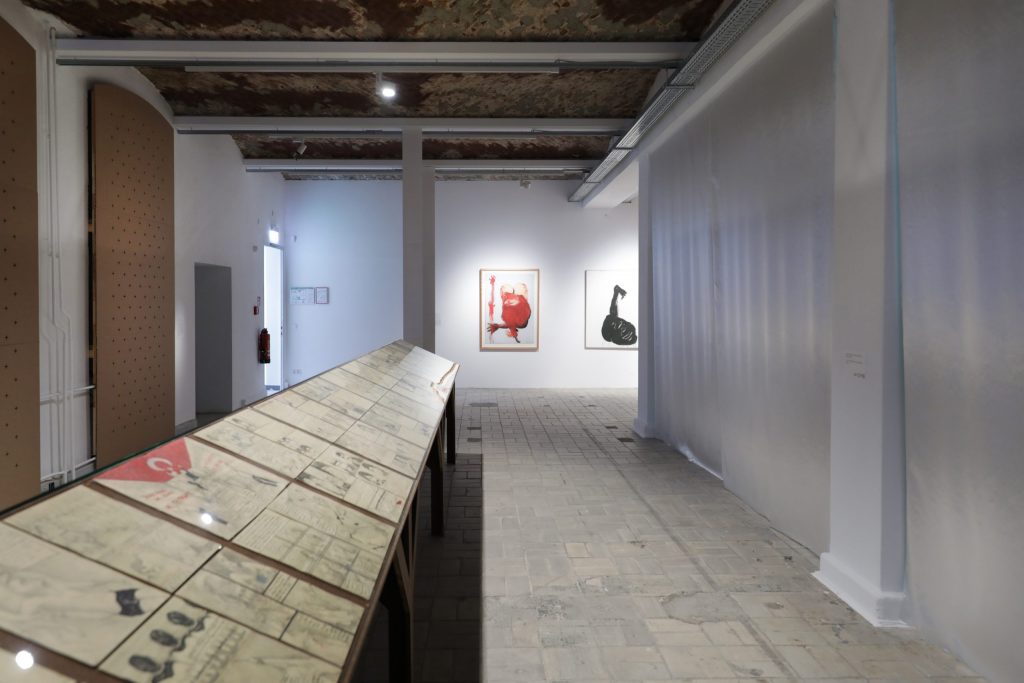
Zehra Doğan, Xêzên Dizî [The Hidden Drawings] (2018–20). Installation view (detail), 11th Berlin Biennale, KW Institute for Contemporary Art. Courtesy Zehra Doğan
Photo: Silke Briel
Forms of Dissent
During their allotted time slots, press streamed through the now extra-spacious halls at two of Berlin’s major art institutions, the Gropius Bau and KW Institute for Contemporary Art, as well as the daadgalerie. This last chapter of the biennial was preceded by three smaller prelude shows, the first of which opened exactly one year ago at ExRotaprint, a historical former printing press that was occupied by a tenant co-operative in the early 2000s and now functions as a community-driven cultural initiative. That’s a model that sits well with the curators’ message. During the biennial final chapter, the main exhibition, this location serves as an archive of the entire biennial research and exhibition process.
Meanwhile at KW Institute for Contemporary Art, the curators present a chapter themed “The Antichurch” that offers visceral perspectives on the violence of patriarchy and the subversion of it. Among the most striking works are monumental drawings by Argentinian artist Florencia Rodriguez Giles. Generously installed around the institution’s main floor, the detailed canvases in the 2018 series Biodelica depict otherworldly, sometimes nightmarish figures that are part-human, part-animal, and part-vegetable. The figures tout female genitalia and engage in actions driven by the pursuit of pleasure.
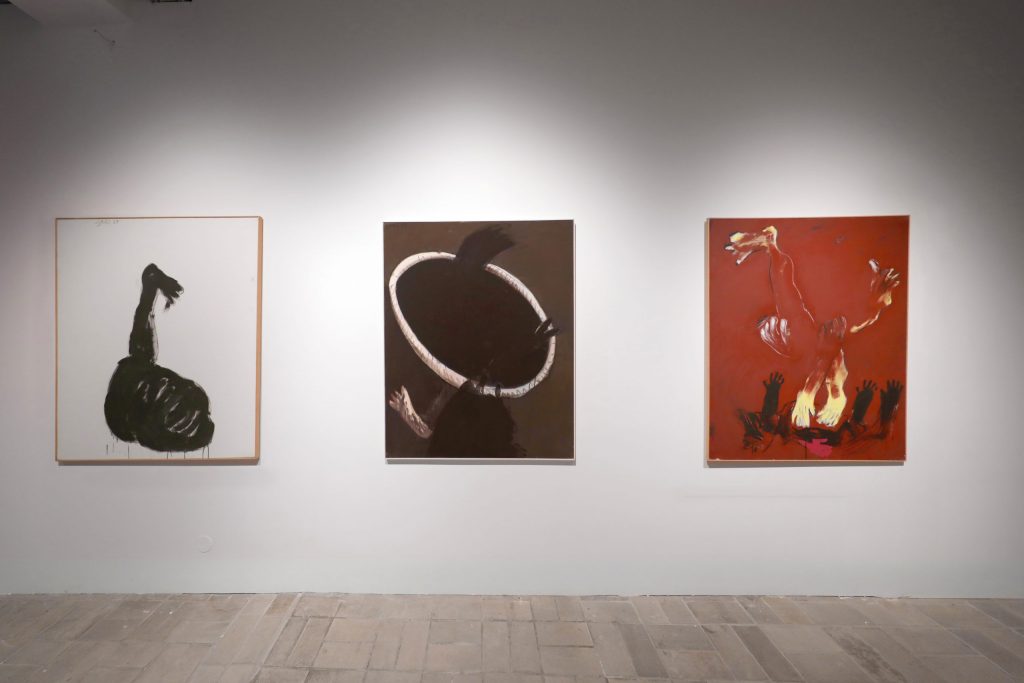
Galli, Installation view, 11th Berlin Biennale, KW Institute for Contemporary.
Photo: Silke Briel
Similarly alluring in their fleshliness are the paintings of entangled, blood-red limbs and torsos by Galli, installed on KW’s second floor. A female member of Berlin’s “Junge Wilden” generation of the late 1970s and early 1980s—a bohemian, male-dominated group of artists, including Albert Oehlen, who all favored an expressive style of painting over the minimalist visual language of that time—Galli’s works have rightfully gained latent appreciation in the past five years. Alongside several canvases, her books of collages are also on display in glass cases as well as in a video. The artist’s hands, filmed leafing through the pages, hint towards her differently abled body.
However, it’s a common drawback of exhibitions that seek to convey forms of community dissent, resistance, and activism through artistic means that they end up feeling more preachy than subversive, more dryly didactic than revolutionary. Too many artworks in the show, which is heavy on video art, fall into this trap. And the effectiveness of much of it is deeply reliant on wall texts. What’s more, if a feminine sensibility, as the argument here goes, is the favorable alternative to masculine rampage, why not cast it in roles less associated with victimhood?
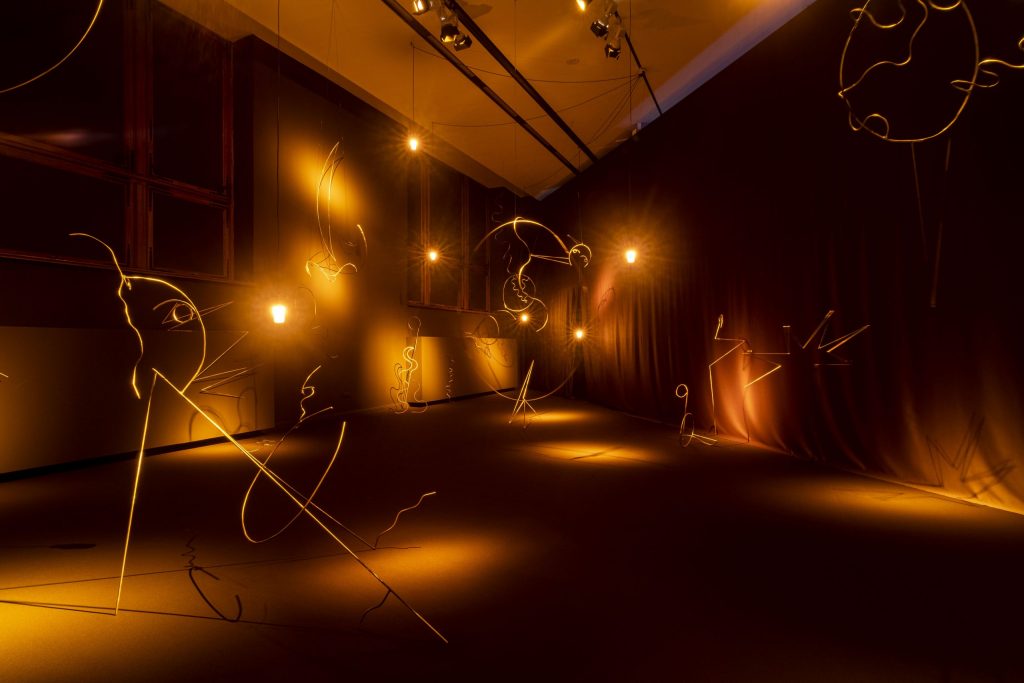
Andrés Pereira Paz, EGO FVLCIO COLLVMNAS EIVS [I FORTIFY YOUR COLUMNS] (2020). 11th Berlin Biennale, Gropius Bau. Courtesy Andrés Pereira Paz; Crisis Galería, Lima; Galería Isla Flotante, Buenos Aires. Photo: Mathias Völzke.
The Cracks Within
The conceptual thread that runs through the chapter installed at Gropius Bau takes the museum as another patriarchal structure in need of critical overhaul. Titled “The Inverted Museum,” this segment includes generous installations that meld sensuous experiences and intellectual engagement. Of the three shows-within-the-show, it is the most successful.
Take Bolivian artist Andrés Pereira Paz’s 2020 installation I Fortify Your Columns, commissioned and co-produced by the biennial, a landscape of minimalist sculptures that occupy the floor, walls, and ceiling of a darkened gallery. A bird’s call resonates throughout the space. It’s the sound of the Amazonian guajojó; when its habitat was ravaged by catastrophic blazes last year, a single specimen managed the extraordinary flight to Bolivia, where its sighting became a local sensation. An asylum seeker rather than a migrating bird, it has no home to return to.
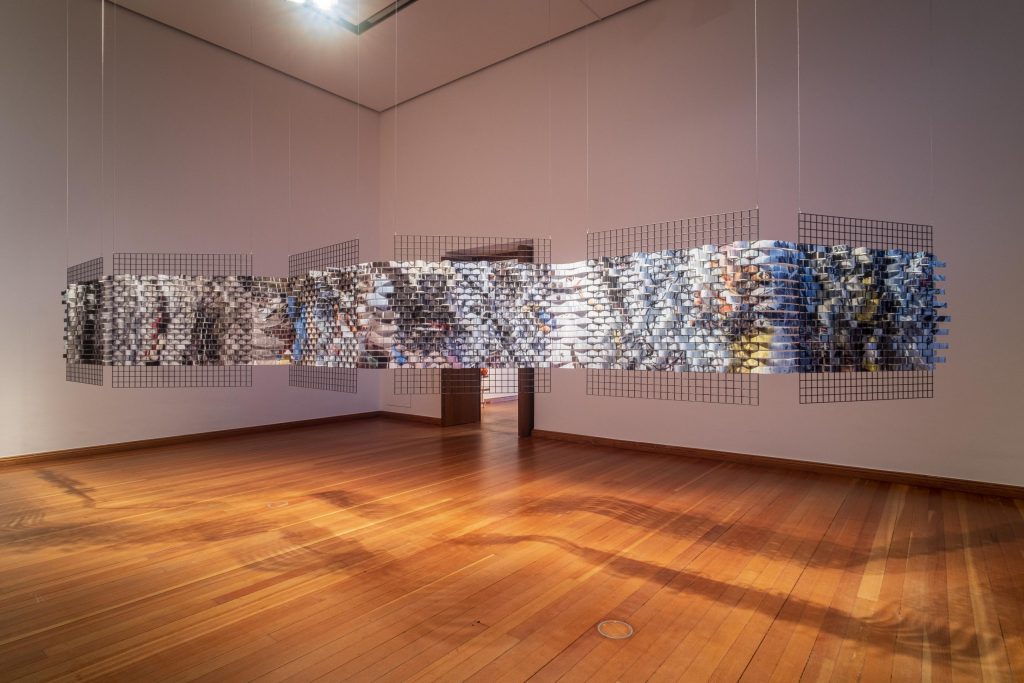
Aykan Safoğlu, Zero Deficit (in Refusal) (2020). Installation view, 11th Berlin Biennale, Gropius Bau. Prints by Lamarts, Istanbul. All works Courtesy Aykan Safoğlu. Commissioned and produced by Berlin Biennale for Contemporary Art. In collaboration with Lamarts, Istanbul. With the support of SAHA Association. With thanks to Academy of Fine Arts Vienna, PhD in Practice, doc.funds. Photo: Mathias Völzke
While the show largely lands on South American soil, several works focus more directly on Europe-centered stories. Turkish artist Aykan Safoğlu digs into his own childhood and education at a renowned German-Turkish school in Istanbul. In a video work narrated by the artist, he weaves his personal history with 19th-century Prussian-Ottoman relations, which were based on Europe’s financial and colonial interests in Ottoman-run Anatolia (modern day Turkey), and the debt collected by European companies who leeched a bankrupt Ottoman Empire. Safoğlu notes that, as a German-speaking man in Istanbul, he is better accepted by German society than his relative who came within a huge Turkish cohort to Germany in the 1960 as “guest workers.”
Other works addressed even more direct situations of persecution. At KW, formerly jailed Kurdish journalist and artist Zehra Doğan showed The Hidden Drawings, which she made on 103 sheets of paper sent from a friend while Doğan was imprisoned in Turkey. The drawings and texts—raw and austere, albeit not without hope—are presented on a long table behind glass, the pages form a graphic novel that depicts experiences lived and witnessed during her incarceration, contextualized within the history of the Kurdish struggle in Turkey that has been going on since the 1980s.
In a separate room at KW, German artist Christine Meisner presents her 2020 work Unsharpness In A Possible, Episode 1: Submissions from Berlin, in which she explores the archives of the weekly Der Stürmer, a tabloid published between 1923 and 1945 that propagated anti-Semitic and Nazi ideologies (its founder was sentenced to death in the Nuremberg trials). Meisner digs out the immense amounts of anti-Semitic material submitted for publication by readers from all over Germany and Nazi-occupied territories; her installation helps to illustrate the culpability of German society at large. It is an issue that persists: Only a week ago, protesters demonstrating against state measures to stop the spread of COVID-19 stormed the steps of the German federal parliament, several waving flags associated with extreme far-right and Neo-Nazi views.
If the biennial title, “The Crack Begins Within,” is at first interpreted as a call for change worldwide—that breaking with old ways begins with personal responsibility—this one work in particular serves as a grim reminder of the dangerous potential this holds. The crack is open, but no one can predict how deep it will get.
The 11th Berlin Biennale is on view until November 1, 2020 at various locations across Berlin.
To learn more about Berlin Art Week here.
